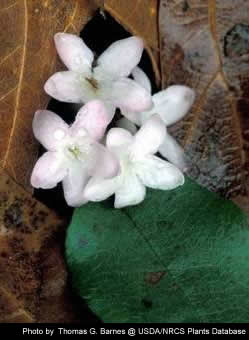

MOUNTAIN STATE FLORA: Trailing Arbutus Springs to Life By Emily Grafton Height is truly not a measure of importance when you consider the historical popularity and the number of sonnets written about this tiny member of the heath family. Never reaching more than a few inches in height, the stems and leaves of trailing arbutus cling tenaciously to the earth as they grow slowly in a vine-like fashion. Trailing arbutus prefers acidic, sandy soils and occurs within both hardwood and coniferous forests. It grows best in partial shade along rock ledges or on steep banks. Also known as little laurel, its ovate-leathery, evergreen leaves resemble those of its bigger cousins in the rhododendron family. Rust-colored hairs cover the wiry stems and undersides of the leaves in varying amounts. Like all members of the heath family, arbutus is adapted to survive in low moisture and nutrient-poor environments. The main allure of this coarse-looking plant is the clusters of bell-shaped flowers with fluted edges. The pinkish flowers produce one of the sweetest, most captivating fragrances in nature. The ½- to ¾-inch-long flowers arise from leaf axils and the ends of individual shoots. Blossoms appear from March to May, and can be seen peeking through a few inches of snow in March. Trailing arbutus was heavily collected from the wild by street vendors in 19th century New England . The “hawkers” would fill their carts with the evergreen plants winter through spring and walk the streets of Boston yelling “Mayflowers for sale.” This name came from the legend told by poets like Whittier and folklorists that blossoms of trailing arbutus greeted the colonists who landed at Plymouth Rock. The relentless harvesting of trailing arbutus from the landscape inspired a group of Boston women to form one of the nation's strongest conservation organizations in the late 19th century. They worked to make trailing arbutus the state plant of Massachusetts and collecting it a criminal offense. This group later became the renowned New England Wildflower Society. While the concerned women of Boston were organizing their conservation efforts, the Shakers had been propagating the plant for medicinal uses. Native Americans used it to treat several ailments, especially problems of the kidneys. The Shakers, who produced the safest and most effective herbal remedies of the 19th century, used it in a formulation to treat kidney stones. Thus, this loveliest of flowers came also to be known as gravel plant. Please do not attempt to transplant trailing arbutus from the wild. It is difficult to propagate. Individual strands or shoots grow out from a central crown that may be hard to locate. If you would like to incorporate trailing arbutus into your wild garden, purchase young plants from nursery propagated stock. Native plant nurseries in West Virginia, Maryland and Virginia sell this species. Call the DNR at 304-637-0245 for a list of native plant suppliers. A list of suppliers is also on the DNR website –www.wvdnr.gov – click on Wildlife Diversity and then Landscaping for Wildlife. --Emily Grafton is a seasonal wildlife biologist stationed in Elkins. |
